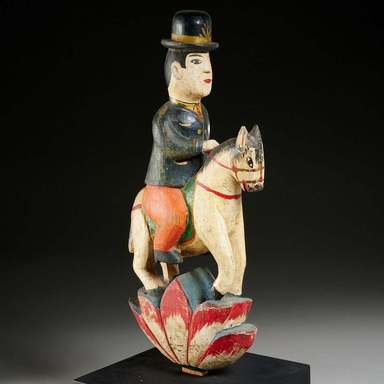
Medium: Wood, polychrome
Geograhical Locations:
Dates:late 19th century
Dimensions: component (Wooden Tang): 3 3/8 x 1/2 x 1 5/8 in. (8.6 x 1.3 x 4.1 cm) overall: 22 1/4 x 4 x 9 in (56.5 x 10.2 x 22.9 cm) (old): mount (m1-2021.17.7): 23 × 14 × 9 in. (58.4 × 35.6 × 22.9 cm)
Collections:
Museum Location: Asian Galleries, South, 2nd floor
Exhibitions:
Accession Number: 2021.17.7
Image: CUR.TL2020.25.11.jpg,
Catalogue Description: Carved wood figure of a man on horseback atop a stylized lotus flower. The man is dressed in Western attire, with bowler hat, blazer, and buttoned shirt. The piece is painted in bright colors. The figure is a kokdu, or bier sculpture, one of many surrounding the coffin of the deaceased on the bier or cart (sangyo) used to transport the deceased to their graves. Often brightly colored and whimsical, these figures served as the entourage and protectors of the deceased during the funerary procession. Among the many standard types of figures included was the Guardian, initially a fierce warrior, who transformed over time into a police officer and then into the Western-dressed man seen here. The practice of decorating the bier with figures appears to have been popular in the late Joseon period and possibly into the period of the Japanese occupation.